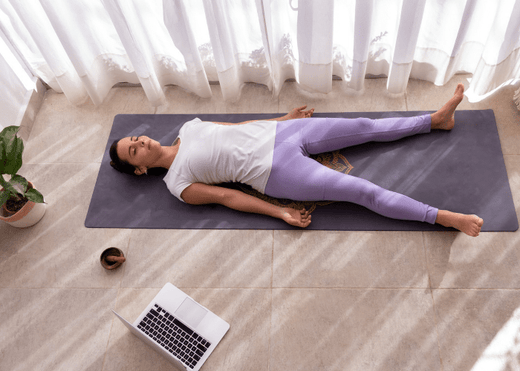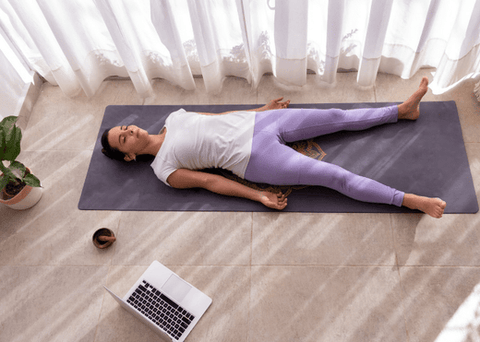My Cart

Everything You Need to know about Yogic Sleep or Yoga Nidra

On this International Yoga Day, we bring you a special edition on how you can easily embark on your healthy sleep journey through consistent yoga practice. Yoga Nidra or Yogic sleep is an ancient Indian method of enabling individuals to attain a positive state of deep physical, mental, and emotional relaxation.
Yoga allows the body and mind to relax deeply. It not only refreshes the mind but also energises the body. Yoga Nidra, or yogic slumber, is a simple relaxation technique that should be used at the end of each yoga pose sequence. Yoga Nidra cools the body down while yoga movements warm it up. This final yoga asana requires you to focus your attention on different regions of your body and relax them. Yoga techniques boost the body’s energy levels. Yoga Nidra aids in the conservation and consolidation of energy as well as the relaxation of the entire system, preparing it for pranayama and meditation. As a result, it’s critical to include enough time for Yoga Nidra in your yoga routine.
In simple words, In Yogic Sleep, the mind does yoga, rather than the body. According to some, 45 minutes of yogic sleep is equivalent to 3 hours of regular sleep. It’s no surprise that yogic sleep is becoming increasingly popular in today’s fast-paced society when we’re always striving to squeeze in more life. You shouldn’t use yogic sleep as an excuse to skip out on your required 7 hours of sleep per night. However, you can make it a part of your daily practice to experience less tension and a more relaxed frame of mind. It may also help you fall asleep faster if you practice it on a regular basis.
What is yogic sleep, exactly?

Yoga Nidra, also known as yogic sleep, is a technique for accessing the subconscious mind. Practitioners of yoga Nidra enter a state of deep relaxation that differs from normal sleep and alertness.
Your thoughts may become less linear as you fall asleep, floating here and there and passing one other in unexpected ways. They may also make you feel less emotionally charged. This is you unlocking your unconscious mind, according to yogic sleep.
Yoga Nidra practitioners experience hypnagogia, which is comparable to hypnagogia. The dream-like condition between sleep and awake known as hypnagogia is characterized by more fluid thoughts. Many people believe it helps them be more creative, therefore they deliberately seek it out.
How’s Yogic Sleep Different from Normal Sleep?

Yoga Nidra is not the same as regular sleeping. Rather, it is a yoga practice that aids in the attainment of a deep state of relaxation.
Your body and mind are both fully relaxed while you sleep. You’re not aware that you’re sleeping since you’re unconscious. When you’re awake, on the other hand, you’re aware of what’s going on in your mind, body, and environment. Yoga Nidra seeks to find a medium ground between these two states of awareness, allowing you to feel as relaxed as possible while remaining conscious.
Depending on whether you’re sleeping or awake, your brain waves alter. Your brain waves are in a beta state when you’re awake. Your brain waves begin to change to an alpha state when you relax. Then you move on to theta waves, which are associated with light sleep, before moving on to the slow waves associated with deep sleep. While you’re awake, yoga Nidra helps you come closer to those theta waves.
The benefits of yoga Nidra have been studied by scientists. The brain scans reveal that the participants are in a resting state akin to sleep, although they are still awake.
The advantages of Yogic Sleep

- You’re not far off if yoga Nidra seems like meditation to you. The goal of yoga Nidra is to induce a sense of quiet, relaxation, and restorativeness. You should feel more serene and grounded when you finish the practice than when you started.
- Yoga Nidra, like meditation, visualization, and other types of yoga, is a spiritual practice that many people find beneficial to their life. It relieves stress and instills a sense of calm in your everyday routine. Your emotions and well-being are more under your control. Your thoughts slow down. You might notice that you’re more attentive and concentrated. You have a stronger bond with individuals and the environment.
- You may live more in the moment when your mind and body are connected.
- Researchers have discovered that yoga Nidra improves blood pressure, heart rate, and psychological well-being in women with menstruation issues, in addition to anecdotal evidence. It also aids diabetics in better controlling their blood glucose levels. These studies focused on yoga Nidra particularly, but there is a lot of data demonstrating that meditation has positive effects on our overall well-being and health, including sleep quality.
- One of the best aspects of yogic sleep is that it can be done by anyone. Anyone, regardless of age or experience, can begin a yoga Nidra practice. Yoga Nidra can be done alone or with others, at home, or in a yoga studio.
How do you do Yoga Nidra?

Do you want to give yogic sleep a try yourself? Look for yoga Nidra workshops in your area, or watch online video tutorials to practice on your own at home. You may also download a variety of guided meditation apps for your phone, including yoga Nidra. A basic outline of a yoga Nidra practice that you can do on your own is as follows:
- Begin by lying down on your back with your arms stretched out by your sides. Use blankets, Pillow, or blocks to support oneself. You want to feel at ease while yet being well-supported. Close your eyes for a moment.
- Begin by relaxing with simple breathing exercises called pranayama. With one hand on your tummy and the other on your chest, practice alternate-nostril breathing or simply attempt taking longer exhales than inhales. Focusing on your breath calms your mind and body while also providing your brain with something to think about.
- Next, make a commitment to yourself to stay awake and set an aim for yourself. The purpose of Yoga Nidra is to achieve a deep state of relaxation rather than sleep. Note that, Yoga Nidra is not about ‘conscious effort’ but rather ‘conscious relaxation.’
- The real work begins now. Start with your left pinky toe and work your way up through your body to your facial muscles, starting with your left pinky toe and continuing through your feet. As your body relaxes deeper into the mat, you become more grounded both mentally and physically by deliberately noticing and then relaxing each body part. As rapidly as possible, but gently, go through this process, becoming aware of each bodily component before going on to the next.
- After that, take a time to take in your entire body before repeating step 4. Step 6 can be skipped if you are sufficiently relaxed.
- Consider a lovely location. Allow your senses to explore the visualization in front of you, whether it’s a lovely garden with twittering birds and drifting flower petals, a peaceful woodland with softly bristling trees, or a peaceful beach scene with gently rolling waves.
- Finally, relax your body and gently become aware of your surroundings.
Yoga Nidra can be practiced for as long as you wish, but the ideal length is 20 to 45 minutes to allow your body to totally relax.
If you don’t mind falling asleep right away, yogic sleep could be a good addition to your evening ritual. Otherwise, you’ll want to practice while you’re already awake and aware, such as first thing in the morning.
This Yoga Day! Switch to relaxing Night-Time Yoga Mode This relaxing 10-minute routine will put you to sleep in no time!
CAT/COW POSE
Inhale and tilt your pelvis back for cow pose, then exhale and tuck your tailbone for cat pose.
COBRA POSE
Make sure your pelvis and legs are firmly rooted to the floor as you lift your chest.
CHILD’S POSE
Spread your knees as wide as your mat. Let your belly rest between your thighs and rest your forehead on the floor.
KNEES-TO-CHEST
Begin by lying on your back, with your legs and arms extended. As you exhale, draw both of your knees to your chest.
LEGS-UP-THE-WALL
Swing your legs up against the wall as you turn to lie flat on your back.



































































